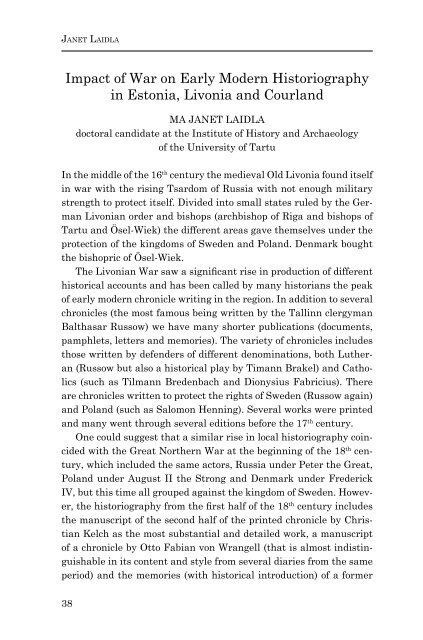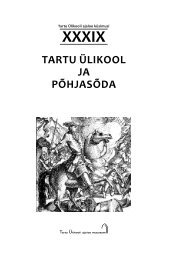TarTu ÜlIkool ja Põhjasõda - Tartu Ülikooli Ajaloo Muuseum
TarTu ÜlIkool ja Põhjasõda - Tartu Ülikooli Ajaloo Muuseum
TarTu ÜlIkool ja Põhjasõda - Tartu Ülikooli Ajaloo Muuseum
You also want an ePaper? Increase the reach of your titles
YUMPU automatically turns print PDFs into web optimized ePapers that Google loves.
Janet LaidLa<br />
Impact of War on Early Modern Historiography<br />
in Estonia, Livonia and Courland<br />
38<br />
MA JANET LAIDLA<br />
doctoral candidate at the Institute of History and Archaeology<br />
of the University of <strong>Tartu</strong><br />
In the middle of the 16 th century the medieval Old Livonia found itself<br />
in war with the rising Tsardom of Russia with not enough military<br />
strength to protect itself Divided into small states ruled by the German<br />
Livonian order and bishops (archbishop of Riga and bishops of<br />
<strong>Tartu</strong> and Ösel-Wiek) the different areas gave themselves under the<br />
protection of the kingdoms of Sweden and Poland Denmark bought<br />
the bishopric of Ösel-Wiek.<br />
The Livonian War saw a significant rise in production of different<br />
historical accounts and has been called by many historians the peak<br />
of early modern chronicle writing in the region In addition to several<br />
chronicles (the most famous being written by the Tallinn clergyman<br />
Balthasar Russow) we have many shorter publications (documents,<br />
pamphlets, letters and memories) The variety of chronicles includes<br />
those written by defenders of different denominations, both Lutheran<br />
(Russow but also a historical play by Timann Brakel) and Catholics<br />
(such as Tilmann Bredenbach and Dionysius Fabricius). There<br />
are chronicles written to protect the rights of Sweden (Russow again)<br />
and Poland (such as Salomon Henning) Several works were printed<br />
and many went through several editions before the 17 th century<br />
One could suggest that a similar rise in local historiography coincided<br />
with the Great Northern War at the beginning of the 18 th century,<br />
which included the same actors, Russia under Peter the Great,<br />
Poland under August II the Strong and Denmark under Frederick<br />
IV, but this time all grouped against the kingdom of Sweden However,<br />
the historiography from the first half of the 18 th century includes<br />
the manuscript of the second half of the printed chronicle by Christian<br />
Kelch as the most substantial and detailed work, a manuscript<br />
of a chronicle by Otto Fabian von Wrangell (that is almost indistinguishable<br />
in its content and style from several diaries from the same<br />
period) and the memories (with historical introduction) of a former



